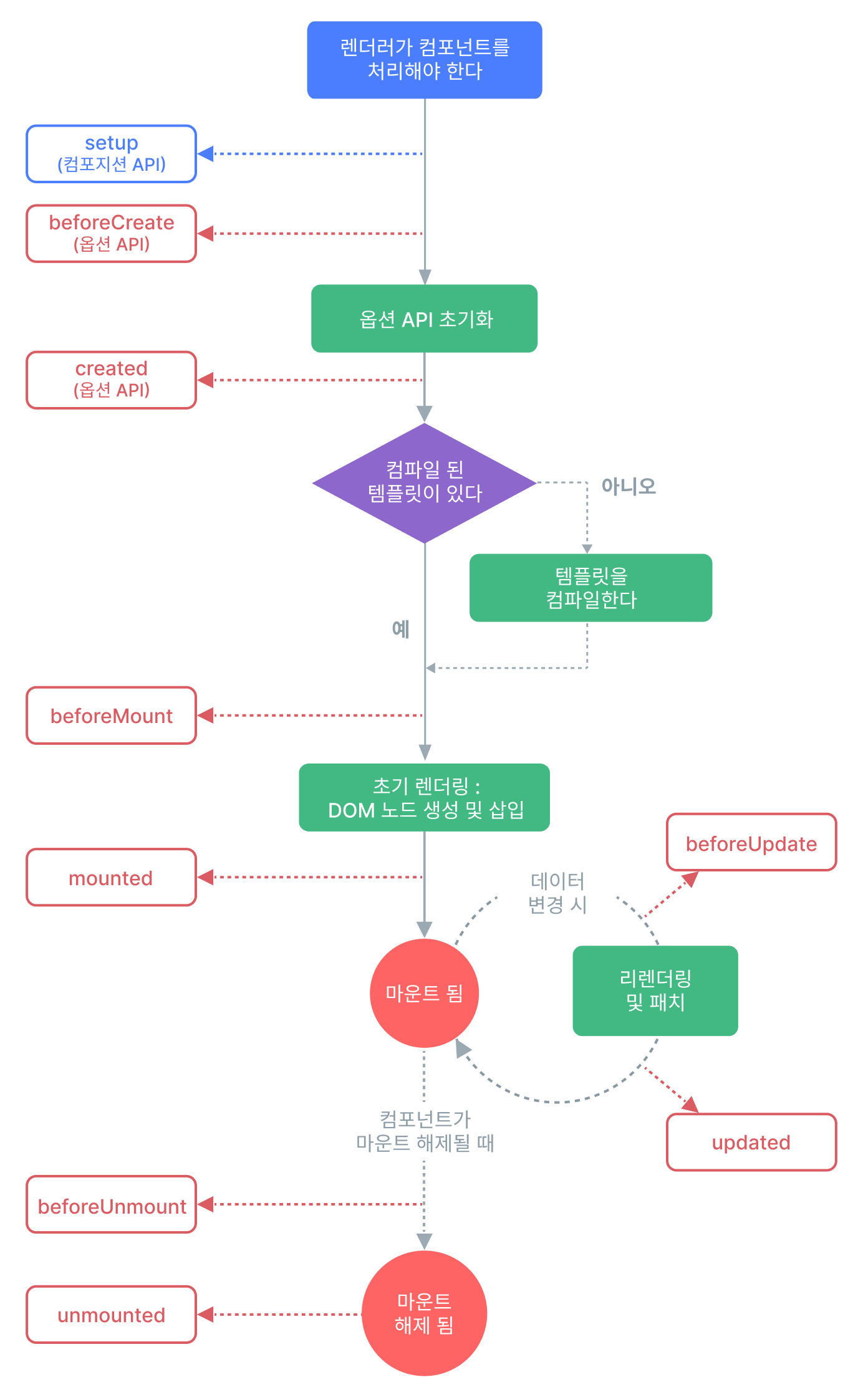npx degit ParkYoungWoong/vue3-webpack-template#eslint vue3-test
기본 Vue의 구조
- Vue의 파일을 가본다면 아래의 코드로 개발을 진행할 수 있다.
// 아래의 코드는 html 코드를 작성하는 란이다.
<template>
<h1 @click="increse()">
{{ count }}
</h1>
</template>
// 아래 란은 JS의 문법 등, Vue에서 제공하는 Js 문법을 작성하는 란이다.
<script>
export default{
data(){
return{
count: 0
}
},
methods: {
increse(){
this.count += 1
}
},
}
</script>
// CSS를 작성하는 란이지만, 필수란은 아니다.
<style>
</style>
조건문과 반복
<template>
<h1 @click="increse()">
{{ count }}
</h1>
<!-- Vue에서 조건문에 해당한다 -->
<div v-if="count>4">
4보다 큽니다!
</div>
<ul>
<!-- vue에서 반복문에 해당한다.-->
<hello
v-for="fruit in fruits"
:key="fruit"
:name="furit">
{{ fruit }}
</hello>
</ul>
</template>
<script>
import Fruit from '~/components/Fruit'
export default{
components:{
hello: Fruit
},
data(){
return{
count: 0,
fruits: ['Apple', 'Banana', 'Cherry']
}
},
methods: {
increse(){
this.count += 1
}
},
}
</script>
<style>
</style>
Vue Lifecycle

npx degit ParkYoungWoong/vue3-webpack-template#eslint vue3-lifecycle
실습 코드
<template>
<h1>{{ count }}</h1>
</template>
<script>
export default {
data() {
return {
count: 2
}
},
beforeCreate(){
console.log('Before Create!', this.count)
// 변수가 정의되기 전이기 때문에 해당 console.log에는 undefined가 나오게 된다.
},
create(){
console.log('Created!', this.count)
// 변수가 정의된 후이기에, 해당 console.log에는 제대로된 값이 나오게 된다.
},
beforeMount(){
console.log('Before Mounted!')
console.log(document.querySelector('h1'))
// html이 렌더링 되기 전이기 때문에, 해당 console.log는 찍히지 않는다.
},
mounted(){
console.log('Mounted!')
console.log(document.querySelector('h1'))
// html이 렌더링 되고 난 후이기 때문에, 해당 console.log에는 count값이 정상적으로 찍힌다.
}
}
</script>
App.vue
템플릿 문법
보간법(Interpolation)
보간법?
- 데이터 바인딩의 가장 기본 형태는 "Mustache"(이중 중괄호 구문)기법을 사용한 문자열 보간법(text interpolation)입니다.
<span> 메시지 : {{ msg }} </span>
v-once 디렉티브를 사용하여 데이터가 변경되어도 갱신되지 않는 일회성 보간을 수행할 수 있다
<span v-once>변하지 않는 변수 : {{ msg }}</span>
실습 코드
<template>
<h1 @click="add">
{{ msg }}
</h1>
<h1
v-once
@click="add">
{{ msg }}
</h1>
</template>
<script>
export default {
data(){
return{
msg: 'Hello world'
}
},
methods:{
add(){
this.msg += '!'
}
}
}
</script>
원시 HTML
v-html
- 이중 중괄호는 데이터를 HTML이 아닌 텍스트로 해석 합니다.
- 실제 HTML을 출력하려면
v-html디렉티브를 사용해야 합니다.
<template>
<h1 @click="add">
{{ msg }}
</h1>
<h1 v-html="msg"></h1>
</template>
<script>
export default {
data(){
return{
msg: '<div sytle="color:red;">Hello world</div>'
}
},
methods:{
add(){
this.msg += '!'
}
}
}
</script>
속성
v-bind
- 이중 중괄호 구문은 HTML 속성에 사용할 수 없습니다
- 대신
v-bind디렉티브를 사용하면 된다. v-bind는 귀찮아서 대부분:를 사용한다.
약어
<!-- v-bind -->
<!-- 전체 문법 -->
<a v-bind:htef="url"> ... </a>
<!-- 약어 -->
<a :href="url"> ... </a>
<!-- 동적 전달 인자와 함께 쓴 약어 -->
<a :[key]="url">...</a>
<!-- v-on -->
<!-- 전체 문법 -->
<a v-on:click="doSomething"> ... </a>
<!-- 약어 -->
<a @click="doSomething"> ... </a>
<!-- 동적 전달 인자와 함께 쓴 약어 -->
<a @[click]="doSomething">...</a>
Computed
computed?
- 계산된 data 라고 생각하면 된다. 즉, 계산된 변수이기에 무조건 return 값이 존재한다.
<template>
<section v-if="hasFruit">
<h1>Fruits</h1>
<ul>
<li
v-for="fruit in fruits"
:key="fruit">
{{ fruit }}
</li>
</ul>
</section>
<section v-if="hasFruit">
<h1>Reverse Fruits</h1>
<ul>
<li
v-for="fruit in reverseFruits"
:key="fruit">
{{ fruit }}
</li>
</ul>
</section>
</template>
<script>
export default {
data(){
return{
fruits:['Apple', 'Banana', 'Cherry']
}
},
// 계산된 data, 즉, 계산된 변수
computed:{
hasFruit(){
return this.fruits.length > 0
},
reverseFruits(){
return this.fruits.map(fruit =>{
// 'Apple' -> ['A','p','p','l','e'] => ['e','l','p','p','A']
return fruit.split('').reverse().join()
})
}
}
}
</script>
Fruites.vue
<template>
<h1>{{ reverseMessage }}</h1>
<h1>{{ reverseMessage }}</h1>
<h1>{{ reverseMessage }}</h1>
<h1>{{ reverseMessage }}</h1>
</template>
<script>
import Fruits from '~/components/Fruits'
export default {
components: {
Fruits
},
data() {
return {
msg: 'Hello Computed!'
}
},
methods: {
reverseMessage(){
return this.msg.split('').reverse().join('')
}
}
}
</script>
- 위와 같이 Method를 4번 호출하게 된다면, 같은 로직이 4번 실행 되게 된다.
- 해당 호출이 많아질 수록 부하가 많아질 수밖에 없다.
- 하지만 아래처럼
computed를 추가한 후에 아래와 같이 코드를 변경한다면,
<template>
<h1>{{ reversedMessage }}</h1>
<h1>{{ reversedMessage }}</h1>
<h1>{{ reversedMessage }}</h1>
<h1>{{ reversedMessage }}</h1>
</template>
<script>
import Fruits from '~/components/Fruits'
export default {
components: {
Fruits
},
data() {
return {
msg: 'Hello Computed!'
}
},
computed:{
reversedMessage(){
return this.msg.split('').reverse().join('')
}
},
methods: {
reverseMessage(){
return this.msg.split('').reverse().join('')
}
}
}
</script>
App.vue
computed자체에 캐싱 기능이 있기 때문에, 의미 없는 호출과 반복을 줄 일 수 있어서 최적화가 가능해진다.
compute의 방식
- compute는 읽기 전용이므로 해당 변수로 어떤 작업을 진행 할 수는 없다.
...
compute:{
reversedMessage(){
return this.msg.split('').reverse().join('')
}
},
methods: {
add(){
this.reversedMessage += '!?'
// 해당 로직은 정상적으로 먹지 않는다.
}
}